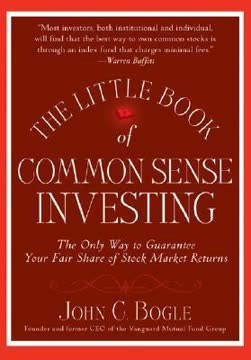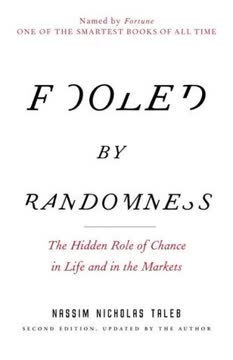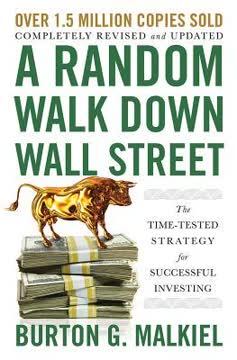Key Takeaways
1. Markets are efficient: Stock prices reflect all available information
No one person or institution consistently knows more than the market.
Efficient Market Hypothesis (EMH): This theory suggests that stock prices quickly adjust to new information, making it difficult for investors to consistently outperform the market. The EMH comes in three forms:
- Weak form: Past price movements cannot predict future prices
- Semi-strong form: Public information is quickly incorporated into stock prices
- Strong form: Even insider information is reflected in stock prices
Implications for investors:
- It's challenging to consistently "beat the market" through stock picking or market timing
- Technical analysis (studying past price patterns) is unlikely to yield consistent profits
- Fundamental analysis may not provide a significant edge in a highly efficient market
2. Embrace index investing for long-term wealth accumulation
Simply buying and holding the stocks in a broad market index is a strategy that is very hard for the professional portfolio manager to beat.
Index fund advantages:
- Low costs: Minimal management fees and trading expenses
- Broad diversification: Exposure to a wide range of companies and sectors
- Tax efficiency: Lower turnover results in fewer taxable events
- Consistent performance: Tends to outperform actively managed funds over the long term
Historical evidence: Numerous studies have shown that the majority of actively managed funds underperform their benchmark indexes over extended periods. This underperformance is largely due to higher fees and the difficulty of consistently making successful stock picks or market timing decisions.
Implementation: Investors can easily build a diversified portfolio using low-cost index funds or ETFs that track broad market indexes such as the S&P 500, total stock market, or international markets.
3. Diversification is key to reducing portfolio risk
Diversification reduces risk and makes it far more likely that you will achieve the kind of good average long-run return that meets your investment objective.
Benefits of diversification:
- Reduces unsystematic (company-specific) risk
- Smooths out portfolio returns over time
- Provides exposure to different asset classes, sectors, and geographic regions
Diversification strategies:
- Across asset classes: Stocks, bonds, real estate, commodities
- Within asset classes: Different sectors, company sizes, and styles (growth vs. value)
- Geographic diversification: Domestic and international markets
Modern Portfolio Theory: This framework, developed by Harry Markowitz, demonstrates how diversification can potentially increase returns while reducing risk. By combining assets with low correlation, investors can create portfolios with better risk-adjusted returns.
4. Asset allocation should align with your life stage and risk tolerance
A thirty-four-year-old and a sixty-eight-year-old saving for retirement should use different financial instruments to accomplish their goals.
Life-cycle investing: Your asset allocation should evolve as you progress through different life stages:
- Young investors: Higher allocation to stocks for growth potential
- Mid-career: Gradual shift towards a more balanced portfolio
- Near retirement: Increased focus on capital preservation and income generation
Risk tolerance factors:
- Time horizon: Longer time horizons allow for more risk-taking
- Income stability: Stable income sources can support higher risk in investments
- Financial goals: Different objectives (e.g., retirement vs. home purchase) require different strategies
Practical implementation: Consider target-date funds or robo-advisors that automatically adjust asset allocation based on your age and risk profile.
5. Avoid market timing and frequent trading to maximize returns
The correct holding period for the stock market is forever.
Pitfalls of market timing:
- Difficulty in consistently predicting market movements
- Missing out on the market's best days can significantly reduce long-term returns
- Increased transaction costs and potential tax consequences
Buy-and-hold strategy benefits:
- Captures long-term market growth
- Reduces trading costs and taxes
- Eliminates emotional decision-making during market volatility
Investor behavior: Studies show that individual investors often underperform the market due to poorly timed buy and sell decisions. Staying invested and resisting the urge to react to short-term market fluctuations is crucial for long-term success.
6. Understand the relationship between risk and reward in investing
Higher risk is the price one pays for more generous returns.
Risk-return tradeoff:
- Higher-risk investments (e.g., stocks) offer potential for higher returns
- Lower-risk investments (e.g., bonds) typically provide more stable but lower returns
Historical evidence: Long-term data shows that riskier assets like stocks have outperformed safer assets like bonds over extended periods. However, this comes with greater short-term volatility and potential for losses.
Risk management strategies:
- Diversification across asset classes
- Matching investment horizon with risk tolerance
- Regular portfolio rebalancing
- Understanding your personal risk capacity and tolerance
7. Be wary of investment fads and bubbles in the market
Every successful investor must decide the trade-off he or she is willing to make between eating well and sleeping well.
Characteristics of market bubbles:
- Excessive optimism and speculation
- Disregard for fundamental valuations
- Widespread belief in a "new era" or paradigm shift
Historical examples:
- Tulip mania (1630s)
- Dot-com bubble (late 1990s)
- Housing bubble (mid-2000s)
Investor psychology: Understand common behavioral biases that contribute to bubbles:
- Herding: Following the crowd without proper analysis
- Overconfidence: Overestimating one's ability to pick winners
- Recency bias: Giving too much weight to recent events
8. Consider tax implications and costs when making investment decisions
Costs matter when buying mutual funds or ETFs. There is a strong tendency for those funds that charge the lowest fees to the investor to produce the best net returns.
Tax-efficient investing strategies:
- Utilize tax-advantaged accounts (e.g., 401(k)s, IRAs)
- Hold tax-efficient investments in taxable accounts
- Consider tax-loss harvesting to offset gains
Importance of low costs:
- Expense ratios directly impact returns
- Lower-cost funds tend to outperform higher-cost alternatives over time
- Compounding effect of fees over long periods can be substantial
Cost considerations:
- Expense ratios of mutual funds and ETFs
- Trading commissions and bid-ask spreads
- Account maintenance fees
- Tax costs from frequent trading or high turnover
9. Dollar-cost averaging can help mitigate market volatility
Dollar-cost averaging can be a useful, though controversial, technique to reduce the risk of stock and bond investment.
How dollar-cost averaging works:
- Invest a fixed amount at regular intervals
- Buy more shares when prices are low, fewer when prices are high
- Reduces the impact of market timing and emotional decision-making
Benefits:
- Smooths out the effects of market volatility
- Enforces disciplined, regular investing
- Potentially lowers average cost per share over time
Considerations:
- May underperform lump-sum investing in consistently rising markets
- Requires discipline to maintain during market downturns
- Best suited for investors with regular income and long-term horizons
10. Rebalance your portfolio periodically to maintain desired asset allocation
Rebalancing can reduce risk and, in some circumstances, increase investment returns.
Importance of rebalancing:
- Maintains target asset allocation as market values change
- Forces a "buy low, sell high" discipline
- Helps manage overall portfolio risk
Rebalancing strategies:
- Time-based: Rebalance at set intervals (e.g., annually)
- Threshold-based: Rebalance when allocations drift beyond predetermined limits
- Combination: Use both time and threshold triggers
Implementation considerations:
- Consider tax implications when rebalancing in taxable accounts
- Use new contributions to rebalance when possible
- Be mindful of transaction costs, especially for smaller portfolios
Last updated:
FAQ
What's A Random Walk Down Wall Street about?
- Investment Strategies Overview: The book offers a comprehensive guide to investing, focusing on understanding market behavior and the unpredictability of stock prices.
- Random Walk Theory: It introduces the concept that stock price movements are largely unpredictable, and past performance does not reliably indicate future results.
- Investment Advice: Malkiel advocates for a buy-and-hold strategy using index funds, which he argues outperform actively managed funds over the long term.
Why should I read A Random Walk Down Wall Street?
- Timeless Investment Principles: The book distills decades of investment wisdom into practical advice, making it valuable for both novice and experienced investors.
- Understanding Market Psychology: It explores psychological factors influencing investor behavior, helping readers avoid common investing pitfalls.
- Evidence-Based Analysis: Malkiel supports his arguments with historical data and case studies, providing a solid foundation for his investment strategies.
What are the key takeaways of A Random Walk Down Wall Street?
- Index Fund Superiority: Malkiel emphasizes that investors are better off buying and holding index funds than actively trading individual securities.
- Market Efficiency: The book discusses the Efficient Market Hypothesis, suggesting stock prices reflect all available information, making it hard to outperform the market.
- Behavioral Finance Insights: It highlights how psychological biases can lead to irrational investment decisions.
What is the Random Walk Theory in A Random Walk Down Wall Street?
- Definition of Random Walk: Future stock price movements cannot be predicted based on past prices, suggesting randomness in stock selection.
- Implications for Investors: This theory implies that market timing or predicting price movements is largely futile, reinforcing long-term investment strategies.
- Critique of Technical Analysis: Malkiel argues that technical analysis is ineffective due to the randomness of stock price movements.
What is the Efficient Market Hypothesis (EMH) in A Random Walk Down Wall Street?
- Definition of EMH: The hypothesis asserts that stock prices reflect all available information, making it impossible to consistently achieve higher returns than the market average.
- Forms of EMH: Malkiel discusses weak, semi-strong, and strong forms, with the semi-strong form stating public information is already incorporated into stock prices.
- Implications for Investors: The EMH suggests active trading strategies are unlikely to outperform a simple buy-and-hold strategy in index funds.
How does A Random Walk Down Wall Street address behavioral finance?
- Psychological Biases: Malkiel explores biases like overconfidence and loss aversion, which can lead to irrational decisions.
- Impact on Market Behavior: These biases contribute to market inefficiencies, resulting in bubbles and crashes.
- Investor Strategies: The book offers advice for recognizing and mitigating these biases in investment decisions.
What investment strategies does Malkiel recommend in A Random Walk Down Wall Street?
- Buy-and-Hold Strategy: Malkiel advocates for a long-term approach using index funds, which he argues will outperform actively managed funds.
- Diversification: He emphasizes diversifying investments across various asset classes to reduce risk and enhance returns.
- Avoiding Market Timing: The book advises against trying to time the market, focusing instead on long-term financial goals.
What are the main types of analysis discussed in A Random Walk Down Wall Street?
- Technical Analysis: Involves analyzing past price movements to predict future trends, but Malkiel argues it lacks predictive power.
- Fundamental Analysis: Focuses on evaluating a company's financial health based on earnings and other metrics.
- Comparison of Methods: Malkiel concludes neither analysis consistently leads to superior returns, advocating for index funds instead.
What are the risks associated with investing in stocks as discussed in A Random Walk Down Wall Street?
- Market Volatility: Stocks can experience significant price fluctuations, leading to substantial short-term losses.
- Psychological Factors: Emotional reactions to market movements can lead to poor decision-making, such as panic selling.
- Investment Horizon: The risk decreases with a longer investment horizon, as stocks tend to recover from downturns over time.
How does Malkiel suggest investors should handle their portfolios in A Random Walk Down Wall Street?
- Rebalancing: Regularly rebalance portfolios to maintain desired asset allocation, managing risk and enhancing returns.
- Dollar-Cost Averaging: Consistently invest a fixed amount over time, reducing the impact of market volatility.
- Avoiding Overtrading: Cautions against excessive trading, which can incur high costs and taxes, diminishing returns.
What are the advantages of using index funds as highlighted in A Random Walk Down Wall Street?
- Lower Costs: Index funds typically have lower expense ratios, enhancing net returns over time.
- Market Performance: They allow investors to achieve market returns without extensive research or stock picking.
- Tax Efficiency: Due to lower turnover rates, index funds minimize capital gains distributions and associated tax liabilities.
What are the best quotes from A Random Walk Down Wall Street and what do they mean?
- "Investors would be far better off buying and holding an index fund...": Encapsulates Malkiel's thesis that passive investing is more effective than active trading.
- "A random walk is an obscenity on Wall Street.": Highlights resistance to the idea of unpredictable stock prices, emphasizing tension between theory and practice.
- "The consistent losers in the market... are those who are unable to resist being swept up in some kind of tulip-bulb craze.": Warns against speculative investing and stresses disciplined strategies.
Review Summary
A Random Walk Down Wall Street is widely praised as an essential guide to investing, advocating for passive index fund investing over active stock picking. Readers appreciate Malkiel's clear explanations of financial concepts, historical context, and practical advice. The book is considered accessible to beginners while still offering depth for more experienced investors. Some critics find it repetitive or disagree with the efficient market hypothesis. Overall, most reviewers highly recommend it as a foundational text for personal finance and investing.
Similar Books









Download PDF
Download EPUB
.epub digital book format is ideal for reading ebooks on phones, tablets, and e-readers.





